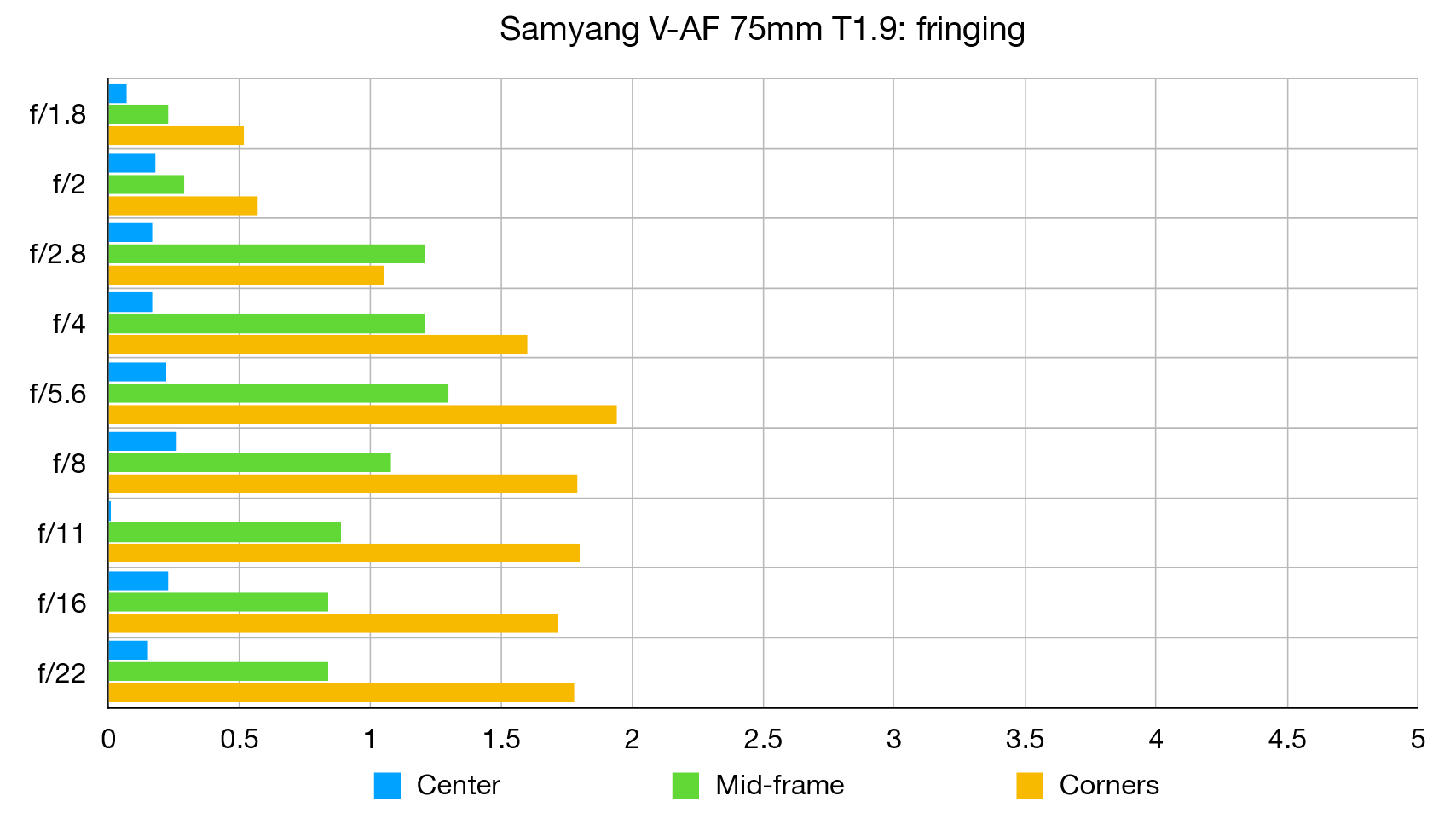Digital Camera World Verdict
Aimed primarily at filmmakers using Sony E-mount cameras, this 75mm lens has a fast T1.9 light transmittance rating, ideal for close-ups and head shots with dreamy bokeh. It excels at the task, with outstanding sharpness and beautiful blurriness, along with excellent color rendition and contrast. Handling is refined and the lens works equally well for high-resolution stills as well as for video up to and including 8K. And it’s a bargain at the price.
Pros
- +
Excellent image quality
- +
Refined handling
- +
Compact ‘unified’ build
Cons
- -
You’ll have to wait for smart accessories
Why you can trust Digital Camera World
The Samyang V-AF 75mm T1.9 is one of five lenses advertised as the world’s first autofocus cine lenses for Sony E-mount cameras. All have the same size and weight, with a unified form-factor, and all have the same T1.9 light transmittance rating. The V-AF 24mm T1.9 and 35mm T.9 are already available and Samyang plans to launch additional 20mm and 45mm lenses later in 2023, to complete the set. These Samyang lenses are being sold under the Rokinon label in the US. All are full-frame compatible and also work on Sony’s APS-C format E-mount cameras, where the 75mm lens has a boosted ‘effective’ focal length of 112.5mm.
Read more:
Samyang V-AF 24mm T1.9 review
Samyang V-AF 35mm T1.9 review
Specifications
Mount: Sony E (FE)
Full-frame: Yes
Autofocus: Yes
Stabilization: No
Lens construction: 10 elements in 9 groups
Angle of view (FF / APS-C): 32.9 / 21.9 degrees
Diaphragm blades: 9
Maximum aperture: T1.9
Minimum focusing distance: 0.69m
Maximum magnification ratio: 0.13x
Filter size: 58mm
Dimensions: 72x72mm
Weight: 280g
Key features
Designed for cinema-quality tight shots, the lens packs a short telephoto focal length of 75mm with a fast T1.9 light transmittance rating into a surprisingly small, lightweight build. Indeed, a key feature of Samyang’s V-AF lenses is that they have the same size, weight and center of gravity. This makes short work of swapping between different lenses to gain your preferred focal length, without needing to make any adjustments to a gimbal. At 280g each, the lenses are also sufficiently lightweight and convenient for aerial videography with a drone.
For a readily accessible status display, the lenses all feature dual tally lamps, one on the side of the barrel and another built into the front. This makes it easy to see when recording is live, whether you’re an operator or the subject in front of the lens.
Build and handling
Build quality is solid and the lens features six weather-seals around all the joints, mode switch and function button, which we’ll come to later. As well as featuring a metal mounting plate for attaching the lens to the camera, there’s a secondary mounting plate at the front, complete with electronic connections. This enables attachment of a range of smart Samyang accessories, the only catch being that there aren’t any just yet. Samyang plans to start launching them later in 2023.
Handling is enhanced by the provision of a dual mode switch and an AF hold button. The action of these can be customized, using the Samyang Lens Station which is sold separately. The same goes for the geared focus ring which, by default, has 300 degrees of rotational travel and operates in a linear fashion. Just as with the AF hold and mode switch, the nature of manual focusing can be customized with the optional Lens Station. Autofocus is courtesy of a linear stepping motor which, as usual for the breed, is fast and virtually silent in operation, as well as enabling smooth transitions during video capture.
Performance
You don’t need exemplary levels of optical sharpness for video capture but the Samyang delivers nonetheless, making it highly suitable for ‘hybrid photographers’ shooting stills as well as video. And while sharpness is utterly excellent, the quality of bokeh is soft, dreamy and remains of high quality when stopping down a little, helped along by a well-rounded 9-blade diaphragm.
Both lateral and axial chromatic aberrations are negligible at wide apertures, although LCA can become slightly noticeable towards the edges and corners of the frame at medium to narrow apertures. It’s not quite a zero-distortion lens but there’s only very little pincushion that will generally go unnoticed. Further attractions include minimal vignetting and good resistance to ghosting and flare.
Another performance asset is that color rendition is very uniform across all of the Samyang V-AF lenses that we’ve seen so far, which saves any headaches when swapping between lenses during a shoot. Samsung assures that the two forthcoming 20mm and 45mm lenses in the range will follow suit.
The best camera deals, reviews, product advice, and unmissable photography news, direct to your inbox!
Sample images
Lab results
We run a range of lab tests under controlled conditions, using the Imatest Master testing suite. Photos of test charts are taken across the range of apertures and zooms (where available), then analyzed for sharpness, distortion and chromatic aberrations.
We use Imatest SFR (spatial frequency response) charts and analysis software to plot lens resolution at the center of the image frame, corners and mid-point distances, across the range of aperture settings and, with zoom lenses, at four different focal lengths. The tests also measure distortion and color fringing (chromatic aberration).
As our Sony a7R III test body reports apertures in f/stop values rather than t/stops, this is how they are recorded in our lab graphs.
Sharpness:
Levels of sharpness across almost the whole image frame are excellent, even wide-open. The extreme edges and corners are very good from wide-open to f/2.8, becoming excellent at f/4 right through to f/16, then dropping off a bit at the narrowest aperture of f/22 due to diffraction. Ultimately, there’s easily enough sharpness to make the most of stills shooting with Sony’s highest megapixel-count cameras.
Fringing:
Axial chromatic aberration or ‘bokeh fringing’ is very negligible even when shooting wide-open. Lateral chromatic aberration can be slightly noticeable at narrower apertures, when uncorrected, towards the edges and corners of the image frame.
Distortion: 0.4
There’s very little pincushion distortion, which will generally go unnoticed even when uncorrected.
Verdict
Aimed primarily at filmmakers using Sony E-mount cameras, this 75mm lens has a fast T1.9 light transmittance rating, ideal for close-ups and head shots with dreamy bokeh. It excels at the task, with outstanding sharpness and beautiful blurriness, along with excellent color rendition and contrast. Handling is refined and the lens works equally well for high-resolution stills as well as for video up to and including 8K. And it’s a bargain at the price.
Read more:
• Best camera lenses to get
• Best Canon lenses
• Best Nikon lenses
• Best Sony lenses
Matthew Richards is a photographer and journalist who has spent years using and reviewing all manner of photo gear. He is Digital Camera World's principal lens reviewer – and has tested more primes and zooms than most people have had hot dinners!
His expertise with equipment doesn’t end there, though. He is also an encyclopedia when it comes to all manner of cameras, camera holsters and bags, flashguns, tripods and heads, printers, papers and inks, and just about anything imaging-related.
In an earlier life he was a broadcast engineer at the BBC, as well as a former editor of PC Guide.













